Chiefs Misery Has Met Its Match: Patrick Mahomes

The worst year, undoubtedly, wasn’t all that long ago, for both Andy Reid and the Kansas City Chiefs. The events of that 2012 season eventually changed everything, even NFL offensive football, for the grieving coach and the team in mourning, for the dad who lost his son and the franchise that had lost its way.
Reid still helmed the Eagles at that point, when his oldest boy, Garrett, died at training camp that August from an accidental drug overdose. At the funeral, the coach ran into his old boss and good friend Mike Holmgren, who pleaded with Reid to concentrate on his mental health and heal for a year. “I can’t do that,” Holmgren recalls Reid saying. “The best thing for me is just to dive back in.”
Holmgren understood. Reid had always been that way, ever since they first hooked up at Brigham Young back in 1982. He wanted to stay the latest, to work the hardest, and some nights he never left the office. Burying himself in even more film study, he hoped, would help him heal. Instead, the Eagles finished 4-12, and Reid was fired, despite his five NFC title game appearances in 14 seasons.
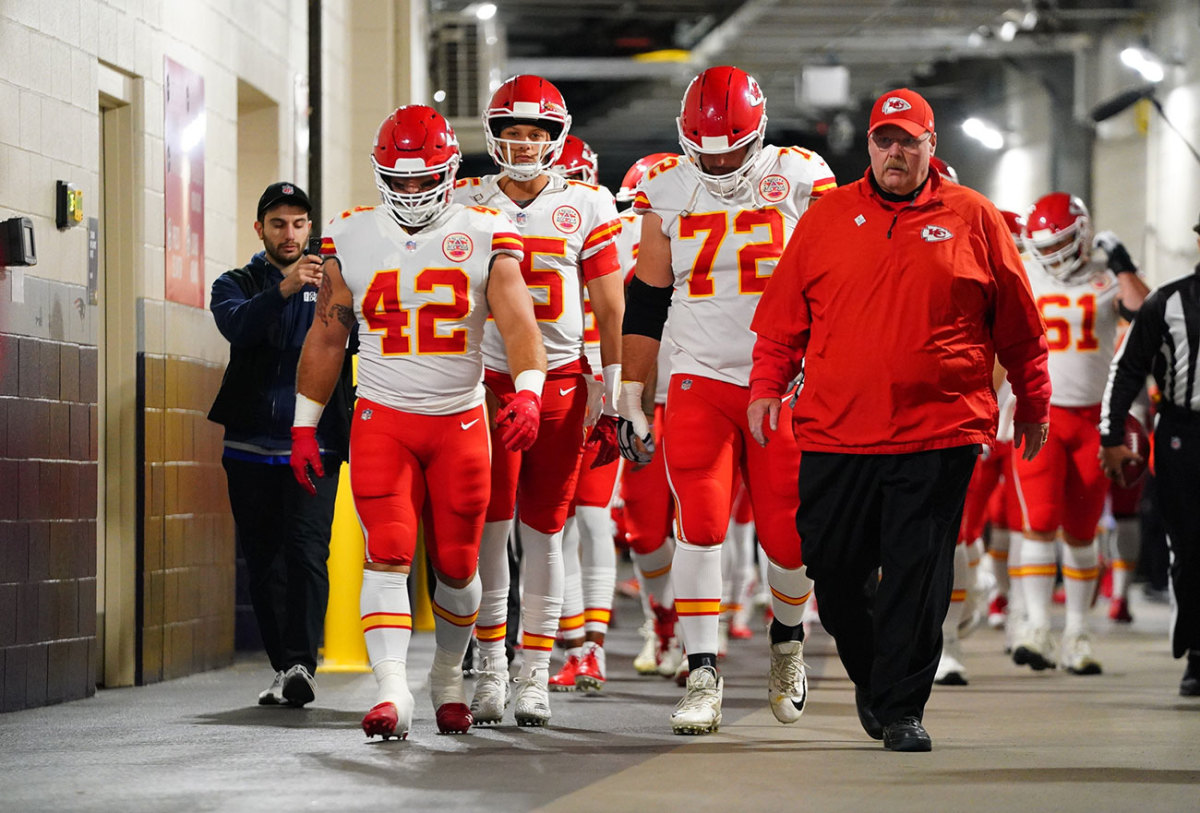
Some 1,100 miles away, in early December that same year, Chiefs linebacker Derrick Johnson arrived at team headquarters on a Saturday and slid into the cold tub, only to be interrupted by frantic members of team security. Someone in the parking lot had a gun, they told him, instructing him to stay inside. “Who?” he asked. “Jovan Belcher,” they responded.
That shocked Johnson. Belcher was both his best friend in football and a fellow inside linebacker, and, if something had been bothering him, he hadn’t said anything or seemed upset in any way. “We did everything together,” Johnson says. “I don’t know what he was going through. I do know it went the worst way.” Johnson wanted to call Belcher, to plead with him, but he never got the chance. Belcher had already shot his girlfriend, and when his head coach, his position coach and the general manager came into the parking lot, he told them he was sorry and shot himself not far from where Johnson sat.
The Chiefs finished 2-14 that season, winning little except the No. 1 overall pick in the upcoming draft, and coach Romeo Crennel was fired. “I can’t imagine a franchise being more in the dumpster than this was,” says Randy Covitz, the longtime writer for The Kansas City Star and something of an unofficial Chiefs historian.
The month after the murder-suicide, the Chiefs went looking for a new football czar, and two separate, gut-wrenching events coalesced into a new partnership. “You might think I’m crazy,” former coach Dick Vermeil told the ownership group in late 2012. “But the coach who just got fired in Philadelphia, Andy Reid, he’s your guy.” That pairing would lead to another series of events that, six years later, would bring to Kansas City the savior to rescue a long-suffering franchise.
Six seasons later, with Reid still in charge and the Chiefs positioned for another playoff run, Vermeil sent Reid a text message. He knew that if the Chiefs topped the Colts in the divisional round, they would, finally, mercifully, host the AFC championship for the first instance in their proud and tortured history. The message he sent read: Andy, this is your year. It’s time. Your time.
One player bolstered that kind of optimism, the quarterback who ultimately might catapult the Chiefs into territory they had never before reached. “Well,” says punter Dustin Colquitt, the team’s elder statesman, now in his 14th season, “obviously we got Patrick.”
BREER:Building a winner—how the blueprints for the Rams, Saints, Chiefs and Patriots stack up
The first factor in the cascade of events that changed everything was Reid using that No. 1 overall pick on Eric Fisher, a tackle from Central Michigan. Fisher wasn’t expecting to be taken that early; he missed a call from a Missouri area code and had to dial the Chiefs right back. His selection furrowed more than a few brows.
Fisher loved everything about the fans in Kansas City, from their unfettered passion to their deep appreciation for team history to the way they tailgated, all the smoke from so many barbecues curling into the crisp air on Sunday afternoons. There was no place like Arrowhead Stadium in pro football, Fisher says. It felt more like a college atmosphere, more festive, “a real intense vibe.”
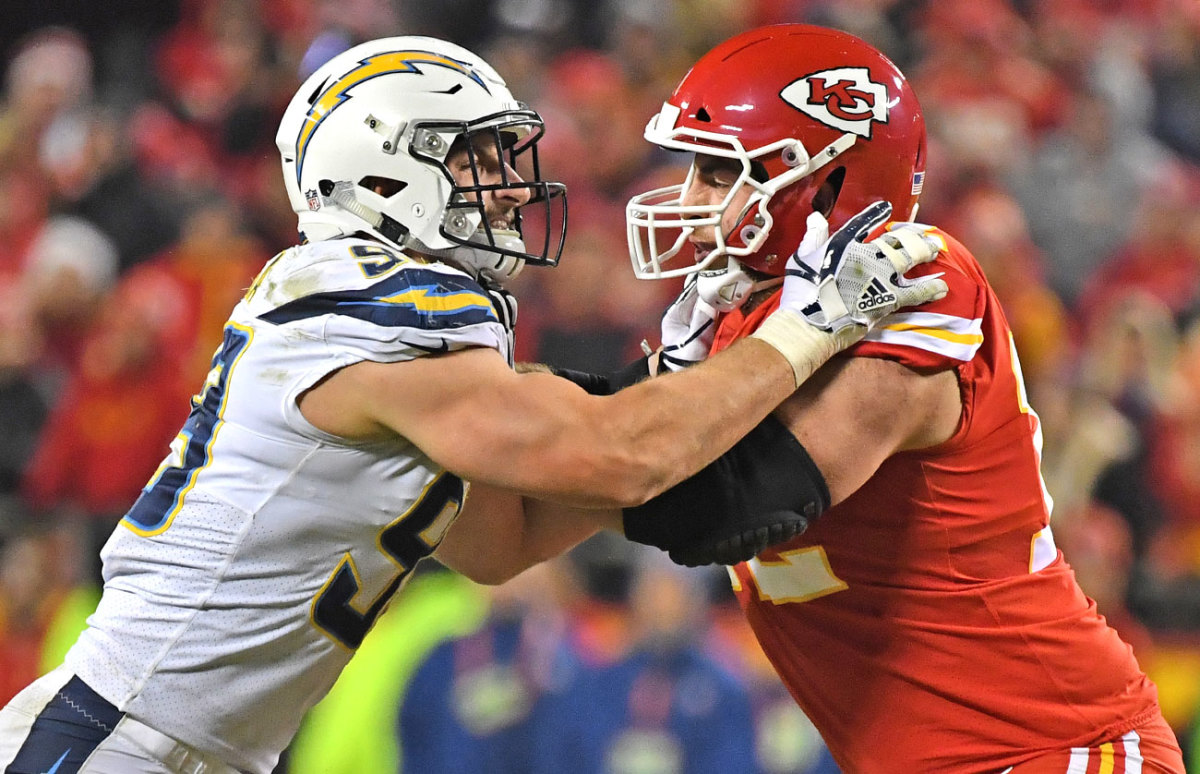
The tackle felt the same even when large swaths of the fan base turned against him, calling him a bust when he struggled early on, suggesting the Chiefs release him. Sure, some of that stuff bothered him, Fisher says, and he had to learn how to ignore all the criticism. But when he made the Pro Bowl this season, he wanted something else. “To give the fans here what they’ve long deserved,” he says.
Those same enthusiasts made game day at the stadium unlike anything else in sports. They screamed so loudly when the Chiefs played defense that to Leigh Steinberg, the agent for “Patrick,” or star quarterback Patrick Mahomes, it sounded “like standing on the deck of an aircraft carrier when the jet takes off.”
The screamers reminded Vermeil of the die-hards in Philadelphia, where he coached before he came to Kansas City in 2001. With one notable difference: The Midwesterners struck him as kinder, gentler; they exhibited a similar passion but less of the boo-Santa-Claus ethos. After losses, Eagles fans screamed at Vermeil to go back to UCLA. Chiefs fans told him, “Tough loss, get ’em next week.”
BENOIT:Mahomes vs. Belichick II—what the Patriots should do differently
Even Super Bowl-winning coaches like Vermeil lament never rewarding those fans with a trip to the championship game. Same for ownership. Vermeil spent 19 years as an NFL head coach or assistant coach, and he says, “My No. 1 regret in my career is I never did a good enough job to hand the Lamar Hunt Trophy to Lamar Hunt.”
Hunt founded not only the Chiefs franchise but the entire American Football League, which merged with the NFL in 1969. He’s credited with coining the term “Super Bowl,” after watching his children play with a popular toy called the Super Ball, and his family is woven into the fabric of NFL history as much as any other, right up there with the Maras in New York, the Rooneys in Pittsburgh and the McCaskeys in Chicago. The AFC championship trophy is named after the Hunts.
Still, Lamar never made his employees feel less than him. When he’d call his general managers at night, he’d first ask if he had phoned too late. When he was inducted into the Hall of Fame, he accepted the honor “on behalf of the fans.” When Vermeil boarded one flight, plopping down in first class, he noticed Hunt headed to the back, his seat in coach. He begged Hunt to switch; the owner declined. “I’m terribly biased,” says Carl Peterson, the Chiefs president and general manager from 1989 to 2008, “but I don’t think anyone contributed more to the success of professional football in the United States than Lamar Hunt.”
Problem was, the longer the Hunts owned the Chiefs, the more playoff heartbreak they endured. They landed successful coaches, like Marty Schottenheimer, Vermeil and Reid. They drafted or otherwise brought in some of the best players in NFL history, including Joe Montana, Derrick Thomas, Will Shields and Tony Gonzalez.
But after Lamar died, his son Clark took over, hiring Scott Pioli from the Patriots to replace Peterson. Pioli ran the Chiefs from 2009 until Reid took over and, Peterson says, “He came in and changed everything, like he just wanted to eradicate the past.” The Chiefs had a game blacked out locally in ’09 for the first time since 1990. The team churned through three coaches in four seasons. Enter Reid, the last of the three, who sought to embrace the history, who Peterson says made “people begin to smile again; look forward to coming to work again.”
Reid redirected the stumbling franchise, starting 9-0 in his first season, leading the Chiefs back to the playoffs. But in 2015, Kansas City opened 1-5. The coach stood before his team in the locker room—but rather than ream them, he said, simply, “We’re not far off.” Johnson, the linebacker, looked around the room. “Like wow,” he says. He admits now that he doubted Reid; he’s sure he wasn’t the only one.
BISHOP:Patrick Mahomes is unfazed by the magnitude of the playoffs
The Chiefs won their next 10 regular-season games, then went 12-4, 10-6 and 12-4 in the next three seasons, winning before the playoffs at a remarkable 72 percent clip. They had overcome everything, even the murder-suicide. Everything except their history. From that ’15 season until this year, they managed a 1-3 mark in the postseason, adding to their distressed history, and in the worst way, as a top team that faded once the playoffs started. They needed that one final piece, which they obtained in the draft two years ago, trading up to select a young quarterback who didn’t become the starter until this season.
“Patrick,” veteran linebacker Justin Houston says.
Peterson slips into a green booth at Winstead’s, the Kansas City steakburger institution, on the day before the Colts game. He will not attend the contest at Arrowhead the next afternoon, and not because of the expected snowfall. Because, heartbreak. Three times during his tenure the Chiefs went 13-3, had a first-round bye, and lost the divisional round game at home. Twice it was to the Colts. “Couldn’t get past the first damn game,” he says. “I’m gonna watch it on TV.”
Few experienced more playoff flops than Peterson, who ran the hard-luck, vanish-when-it-matters Chiefs for almost two decades. His first day on the job, he told the owner, “Your franchise is broke.” He fixed it, hiring Schottenheimer, emphasizing tailgating, patrolling the parking lots with Hunt on game day to judge best-barbecue contests. Kansas City won four AFC West titles, played in the AFC Championship Game after the 1993 season, won more regular-season games than any other team in the 1990s and qualified for the playoffs nine times in his 20 years. But because the Chiefs only recorded six losing campaigns, they usually drafted near the bottom of the first round. “My philosophy was, you’re really rolling the dice with your No. 1, taking a quarterback,” Peterson says.
VRENTAS:The future of football looks a lot like Patrick Mahomes and Andy Reid
That philosophy came to define the Chiefs, who featured many great teams with good quarterbacks (Trent Green), aging legends (Montana) or journeymen (Damon Huard, Matt Cassel, Elvis Grbac). What resulted was the tormented history that can be recited by any Chiefs fan. A brief and respectfully impartial summary of those woes, courtesy of Covitz, the unofficial historian, below:
1971: The Chiefs were two years removed from their Super Bowl IV victory and still loaded with future Hall of Famers when the greatest kicker in franchise history, Jan Stenerud, missed three field goals (one was blocked) against Miami in the divisional round, the double-overtime classic that remains the longest game in NFL history. “It took the franchise 30 years to recover from that,” Covitz says. “If they win that game, the whole karma would have been different.” Kansas City did not reach the playoffs again for 15 seasons.
1990: The Chiefs started a streak of six straight seasons in the playoffs, but lost again to the Dolphins, this time in the wild card round. Kicker Nick Lowery, a three-time Pro Bowler who ranked first in field-goal percentage in NFL history when he retired, missed a tough 52-yard attempt in the final minute that would have won it.
1993: Montana led Kansas City to an overtime victory over Pittsburgh at Arrowhead in the first round, with Lowery making the game-winner. But the Chiefs did not win another home playoff game again until this season. Montana suffered a head injury in the conference championship game at Buffalo. Because, Chiefs. “They just had,” Covitz says, “all these bad luck things.”
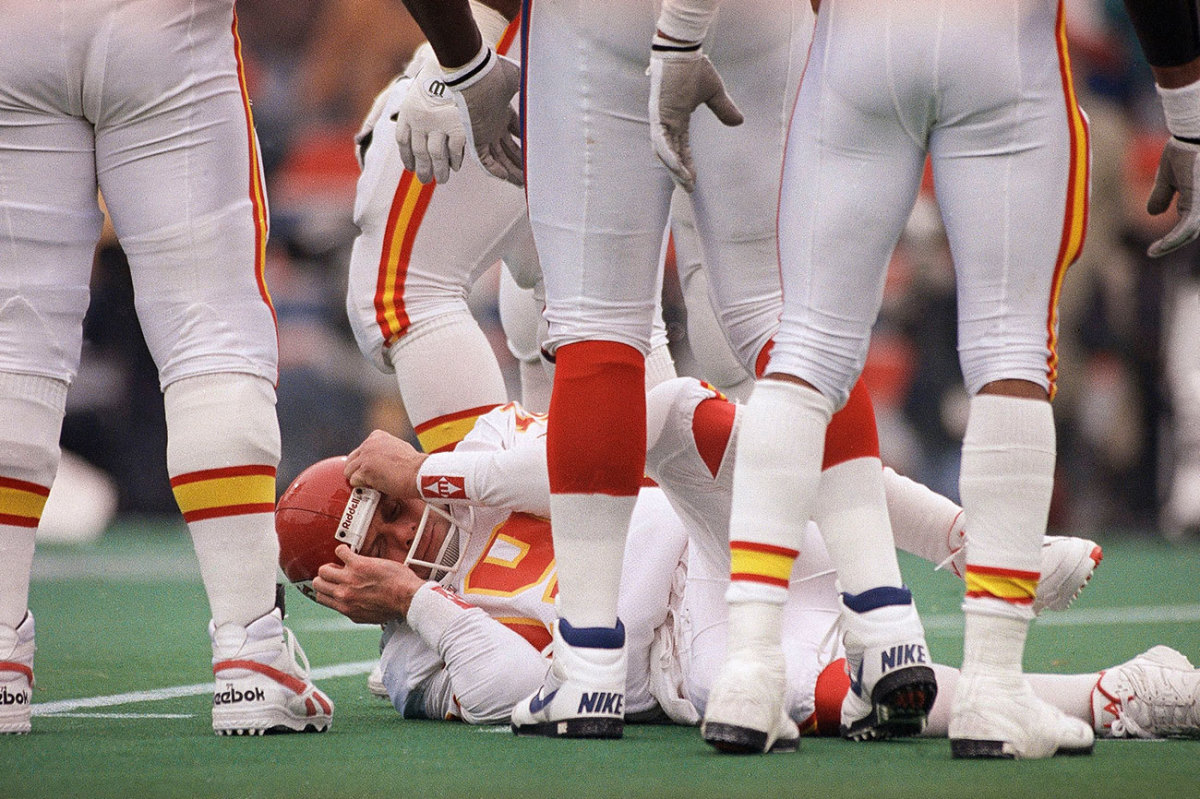
1995: Kicker—another kicker!—Lin Elliott missed three field-goal attempts from 42 yards or shorter. Kansas City fell to—who else?—the Colts. Covitz sighs.
So it went. The Chiefs again lost to the Colts after the 2003 season, when they went 13-3 and undefeated at home and snagged a first-round bye; neither team punted in that game. They fell to Peyton Manning and the Colts—AGAIN, THE COLTS—after the ’06 season. They collapsed against the Colts again—come on!—after the ’13 campaign, as a 38-10 lead dissolved into a 45-44 defeat. Many of these failures featured familiar themes: kicking woes, injuries to key players, ill-timed miscues and what Lamar Hunt used to call “buzzard’s luck.”
Quarterback Alex Smith did manage one playoff win, at Houston three seasons ago. But between Montana’s two victories and that one, the Chiefs dropped eight straight postseason affairs. Buzzard’s luck, indeed. “It sucks. Really,” Johnson says.
So as the latest Colts playoff game approached this January, even though the Chiefs once again secured the conference’s top seed, a palpable sense of doom descended over Kansas City along with the snowstorm. Surely, the weather would slow down Mahomes and the Chiefs’ star-studded offense. If not, of course fate would intervene. “There’s a lot of, not defeatism, but inevitability,” Covitz says. “That’s just the Chiefs in the playoffs. Even here.”
What they needed all along, Steinberg says, was a true, bona fide franchise quarterback. “Otherwise, it’s massive expectations followed by massive deflation; it’s Lucy pulling away the football from Charlie Brown.
“But that’s why they drafted Patrick.”
The usual assortment of NFL denizens gathered at Steinberg’s annual Super Bowl party in Houston in February 2017. Mahomes was there with his father, Pat Sr., and several coaches or general managers who coveted the Texas Tech QB’s services. Among them: Reid, Bruce Arians (Cardinals) and Rick Smith (Texans). What’s funny, looking back now, is that Steinberg gave his annual humanitarian award to Clark Hunt, by then the Chiefs’ chairman. And who presented him that award? One Patrick Mahomes II.
Steinberg tabbed Arizona and Kansas City as the favorites to land his quarterback. He considered the Chiefs, with their stable ownership, their playoff-ready roster, their offensive weapons, their relatively small market and their veteran quarterback in Smith to be an ideal fit. The Saints, Giants, Chargers and Texans also showed interest. The teams that loved Mahomes really loved him, and yet prognosticators had the golden-armed QB all wrong. Years away, they said. A project.
His college coach, Kliff Kingsbury, could only shake his head at the projections that came back, mostly in the second- to third-round range. Mahomes’ mother, Randi Martin, begged her son to stay in school, and if he did, Kingsbury promised to make sure Patrick would cement himself as the first overall pick in ’18. “The more that people said that, the more it cemented his desire to prove them wrong,” Kingsbury says. “Like, just watch, see what happens.” When Saints coach Sean Payton visited Kingsbury, he told the coach, “He’s Favre.”
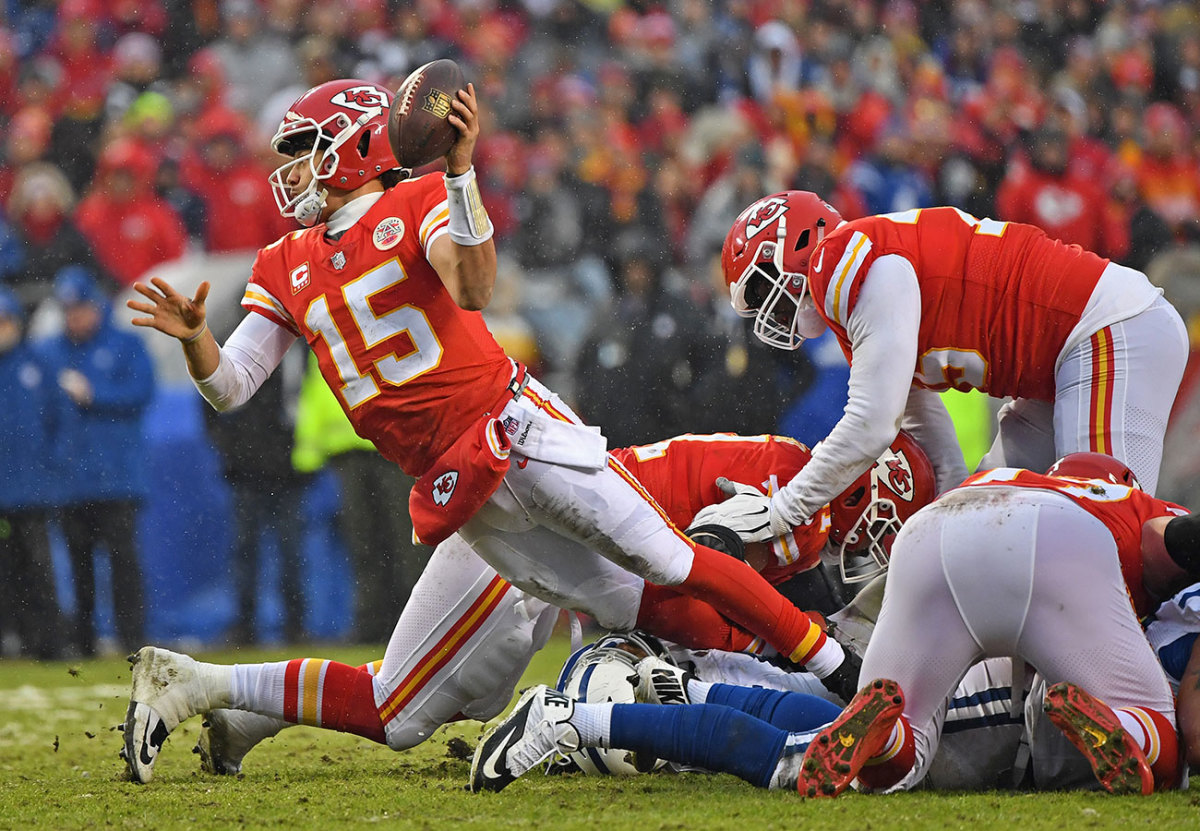
Mahomes decamped to California, training under quarterback whisperer Mike Sheppard. They focused mostly on his three-, five- and seven-step drops. But Mahomes, for all his arm strength, most impressed Steinberg with his memory, which seemed close to photographic. He could remember every significant play that took place in his high school career.
Plus, there was that arm. Always, The Arm. At the end of his pro day, Mahomes slung one ball over the goalpost at the opposite end of the field. He hardly exerted himself and the throw traveled something like 83 yards. Had it been a tighter spiral, Kingsbury says, it might have gone 95. “It was La Bomba,” Steinberg says.
VRENTAS:The Mahomes no-look pass—a brief history
Almost every team in the NFL invited Mahomes in for visits. He traversed the country, collecting hats, even took an Uber from Orlando to Jacksonville when his travel plans got screwed up, showing off his improvisational skills. The Chiefs made their interest clear as far back as January, and yet even Mahomes’ mother hoped he would go “in the top 20, maybe the first round.” His backup at Texas Tech, Nic Shimonek, believed Mahomes’ skill set was “so weird that somebody was really going to have to fall in love with him.” The Chiefs did, trading three picks—two firsts and a third—to move up and take him at 10th overall.
The year he spent behind Smith, 2017, marked a godsend for Mahomes. This wasn’t like when Pat Sr. arrived in Minnesota to try to make the Twins, and when he asked star pitcher Jack Morris how he threw his split-finger fastball, Morris spat back, “Get away from me, you little sonofabitch; you’re trying to take my job.” Smith, instead, did everything he possibly could for the young quarterback who of course wanted to do just that. He told Mahomes where he planned to work out, helped him improve his footwork and taught him how to read defenses, to act professionally, to operate as the face of an iconic franchise.
Those close to Mahomes believed the Chiefs’ plan was always to make him the starter in 2018, which is not unusual for quarterbacks drafted that high. But then Smith played well in ’17, exceptionally so, throwing for 26 touchdowns and more than 4,000 yards, with only five interceptions. Steinberg told Mahomes what he always tells him: stay in process.
Mahomes would call home, telling his father about the plays he had made in practice, so many no-look passes and sidearm deliveries, the balls he fit into shoe box-sized windows. He actually learned the no-look stuff from Shimonek, who played behind Mahomes for two seasons at Tech. Shimonek started throwing passes without looking at his target for slants and run-pass options while bored on the scout team. He continued to do so when he became the backup to Mahomes, who picked up that style and began to compete in practice for who could make the most outlandish throw. “My claim to fame,” Shimonek says now. “If you’re around Pat long enough, he’ll make you a believer.”
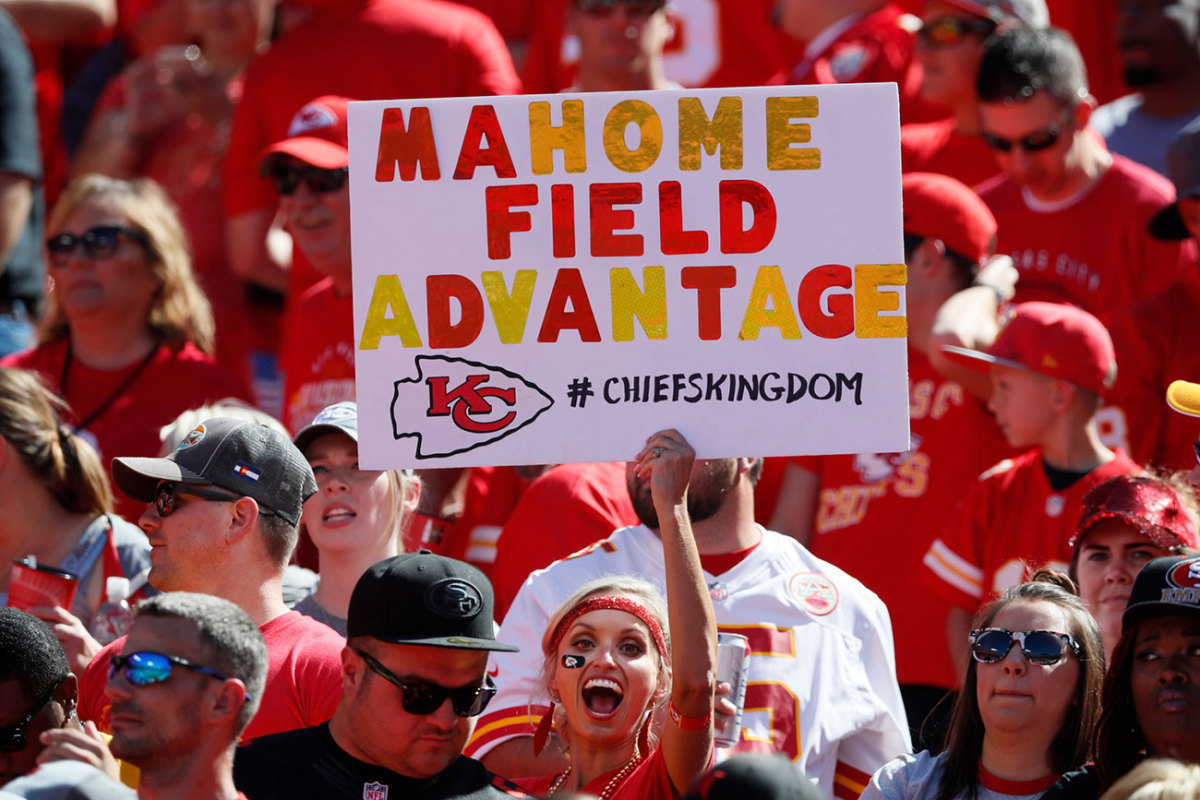
In late January, in the stands of his brother’s basketball game at his alma mater, Whitehouse (Texas) High, Mahomes turned to his mom. “I think they just traded Alex,” he said, and he was right; Smith was headed to the Redskins. Randi immediately started praying. “I don’t know if I’m ready for this,” she said.
Her son was. He went golfing with his dad the next day, still trying to beat the former Major League pitcher turned low-handicap golfer. His son didn’t say much about the trade or what it implied: that he would become the Chiefs’ unquestioned starter. Already, Mahomes had started to call teammates, setting up throwing sessions, making plans for all the work they did this past spring. His godfather, former Major League pitcher LaTroy Hawkins, asked if he was ready to lead grown men. “Yes, sir,” Mahomes II responded.
KLEMKO:Where Patrick Mahomes gets his cool
One of Mahomes’ high school coaches, Brad Cook, told everyone who would listen that they should draft his favorite quarterback in fantasy football. A few rolled their eyes; the lucky ones later told him they’d captured their league championships, as Mahomes became only the second QB in history to surpass 5,000 passing yards and throw 50 touchdowns, boosting the Chiefs to the No. 1 seed in the AFC and setting himself up as the likely league MVP. Before the Colts game, his father sent him a text message. “You were born to do this,” it read.
Steinberg has represented eight No. 1-overall draft picks and several Hall of Famers. None of them ever put together a first playing season like Mahomes. “Not even close,” he says, the day before the Chiefs upend their sad playoff history, topping the Colts—the Colts!—and securing a home date for the conference championship game for the first time ever. Why? “Got a new guy under center,” says Fisher, that first building block, back in 2013. “Showtime. Patrick.”
Because of Mahomes, because of the Chiefs’ innovative offense and because of their touchdown bonanza, this season just felt different, even when Kansas City lost consecutive games in December. “This team is really good,” says Johnson, the former linebacker who would love nothing more than to walk back into the locker room where he spent 13 seasons. “They expect to go all the way.”
After last season ended with another playoff defeat, Johnson went on local radio in Kansas City and said he expected Mahomes would rise to superstar status “real soon.” He still has nightmares about trying to defend the kid in practice. He had always prided himself on reading a quarterback’s eyes; with Mahomes, he never could. But this soon? Face-of-the-NFL good? No one expected that.
Maybe Reid did, if anybody outside of Mahomes’ immediate circles. Like the most innovative coaches in the league, he added several college concepts—jet sweeps, read-options, more shotgun, more empty and four-receiver sets—to tailor his offense to the strengths of his transcendent quarterback. This week Patriots coach Bill Belichick said Reid has evolved his offense to the times and his players’ strengths as well any coach in this era. His unit this year no longer resembled the West Coast offense he learned under Holmgren, who at one point asked him, “Have you forgotten everything I taught you?” Reid just laughed. “He’s adapted beautifully,” Holmgren says. “I don’t even recognize what I’m seeing on the field.”
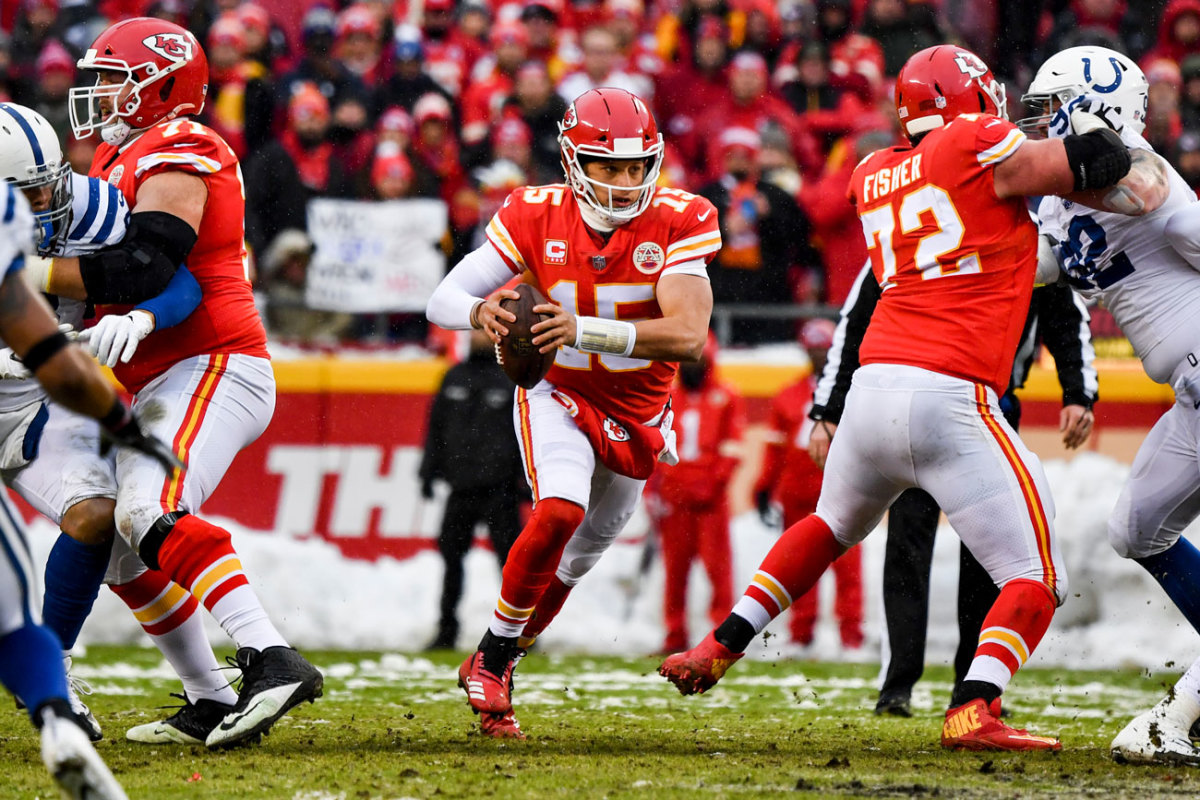
The Mahomes bandwagon filled up one score at a time: four touchdowns thrown against the Chargers in Week 1, six more amassed against the Steelers in Week 2, four more the following week against the 49ers. At that point the bandwagon had filled, to the point where Clark Hunt admits he kept looking at Mahomes, to see if those early, magical performances were outliers. Instead, Mahomes did what Mahomes does, every single week. His life changed as a result. His younger sister, Mia, says kids at school keep saying they’re related to the family. She wants her brother to visit, so he can confirm those kids are not their cousins.
Think of all the dots that connected for the Chiefs to stand here, opposite the Patriots, with a Super Bowl berth at stake on Sunday in the AFC Championship Game. “Coach Reid, we definitely needed him,” Houston says. And Fisher, the bust turned Pro Bowler. And Travis Kelce. And Tyreek Hill. And Mahomes, of course.
The Chiefs even needed Damien Williams, once their third-string running back, who took over for Kareem Hunt when a video surfaced of Hunt kicking and pushing a woman during an argument, and the Chiefs released him in late-November. Mahomes was close to Hunt; they had roomed together during training camp and were part of the same draft class in 2017. Mahomes felt for his friend after his release but he also sent his father a text message. We’ll be OK, it read.
KLEMKO:Alex Smith’s greatest legacy may be the year he mentored Mahomes
They were more than OK against the Colts. Williams scored a touchdown, with Fisher bulldozing a path to the end zone. Mahomes scrambled in for another score. Reid prepared his team so well that they jumped out to a 17-0 lead and never trailed, playoff demons be damned. The defense looked much improved. Houston registered two sacks and said he’d never felt this healthy at this point in the season. The Chiefs looked like a team capable of winning the Super Bowl next month. “We’ve got so many new guys,” Colquitt says. “And they’re used to this. They don’t know about old luck, or Andrew Luck …”
Adam Vinatieri, the best kicker in postseason history, Lowery notes, missed a 23-yard field and an extra point—as if the Chiefs bad luck had transferred. All Lowery could think about was the Hunts. “Now you’re going to make me cry,” he says, as his voice chokes. When he first made the team, in 1980, Clark Hunt was the ballboy and Lowery had been cut 11 times, by eight teams. Clark became his top backer, and Lamar sent him a note when he became the most accurate kicker in league history. He loved that family. Loves. For the Chiefs to win a home playoff game, for them to win a conference championship at home this weekend, “It would be poetry,” he says.
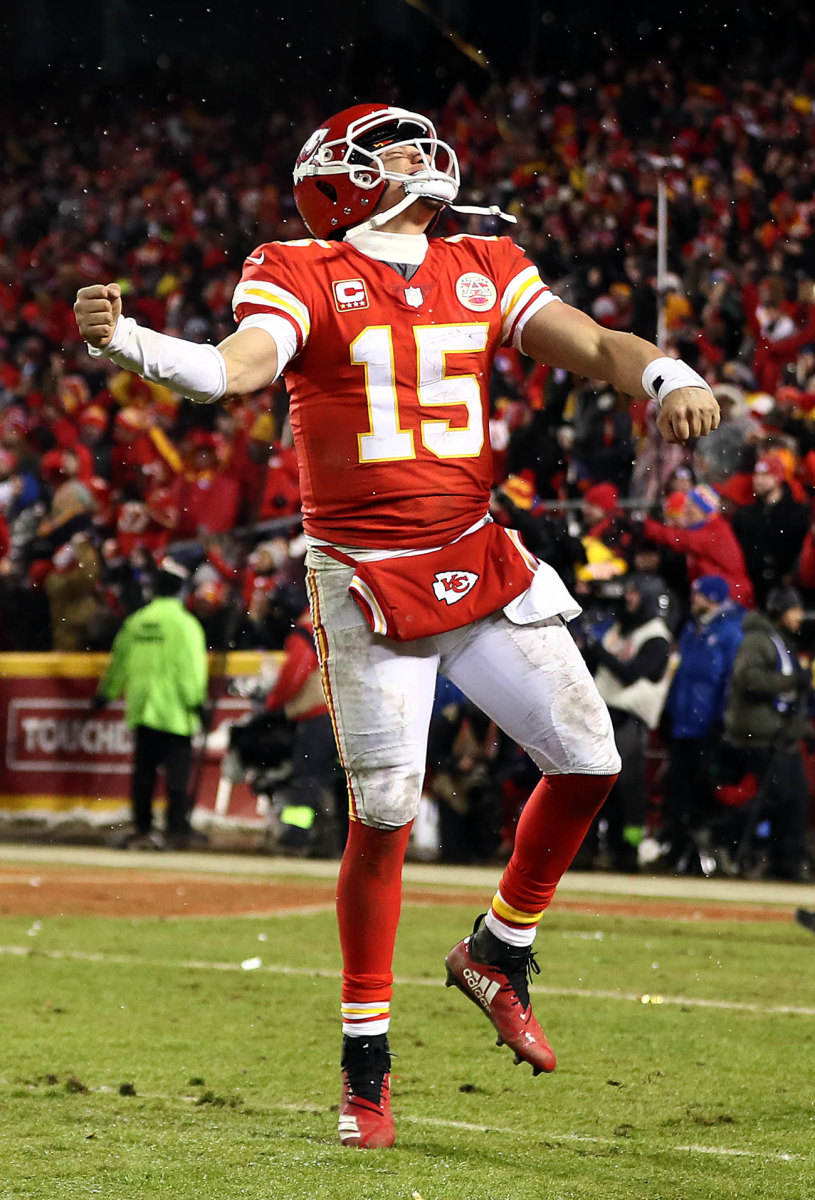
In the suite where the Mahomes family watched the Colts game, relatives snacked on chicken fingers and hot dogs. They waved pom-poms dropped off by team cheerleaders. Pat Sr. sat in the front left, in his lucky seat, imploring Kansas City onward, then lifting his right thumb into the air as his son, the hero, skipped off the field. The kid with no playoff history had laughed at the Chiefs’ postseason demons, and now he will face Tom Brady, in a game rife with potential meaning and a spot in his first Super Bowl. After they played in October, and the Patriots won, Martin told her son, “I’ve gotta give it to Tom Brady. We’re the same age. I can’t imagine playing someone 20 years younger than me. Whatever he’s doing, you need to do.”
For years, Houston heard all the stories about the playoffs and losses and the buzzard’s luck that permeated the football team in Kansas City. He says that won’t happen this year, walking right up to a guarantee but not quite going all Joe Namath. He says in the future Mahomes will make 5,000-yard seasons the new normal in the NFL. But for now, this season, he cares only about a championship. “I feel like we can make it happen this year and we’re going to make it happen this year,” he says. “I’m going to speak it into existence.”
Because, well, Patrick.
Question or comment? Email us at talkback@themmqb.com.
